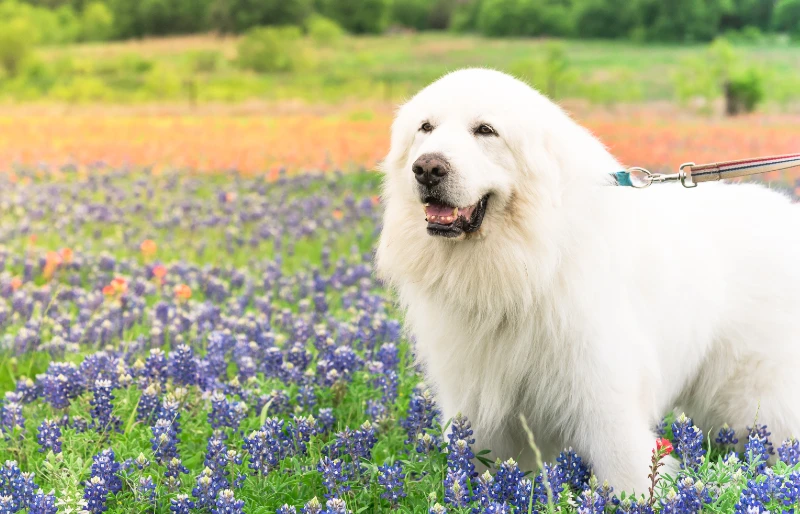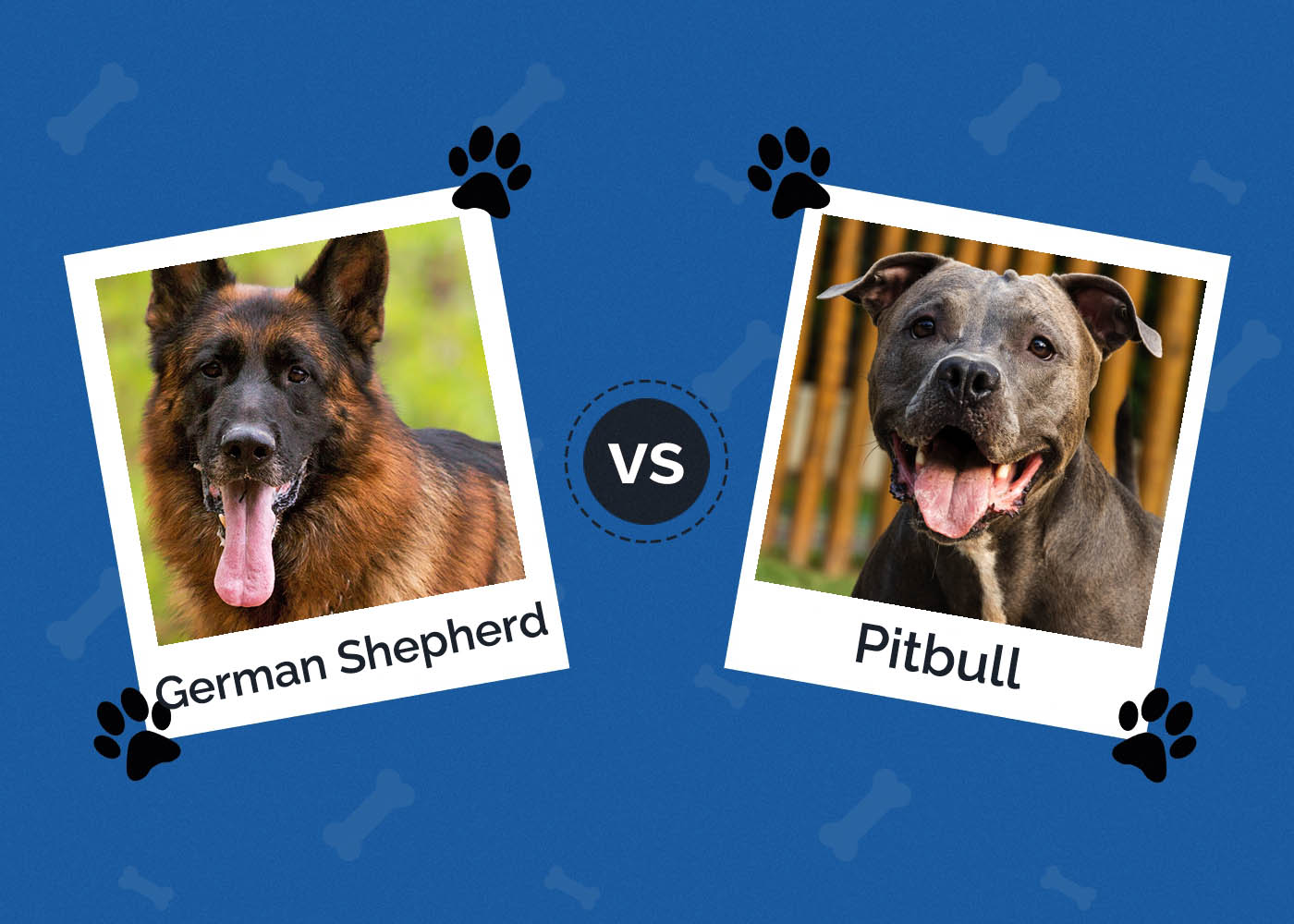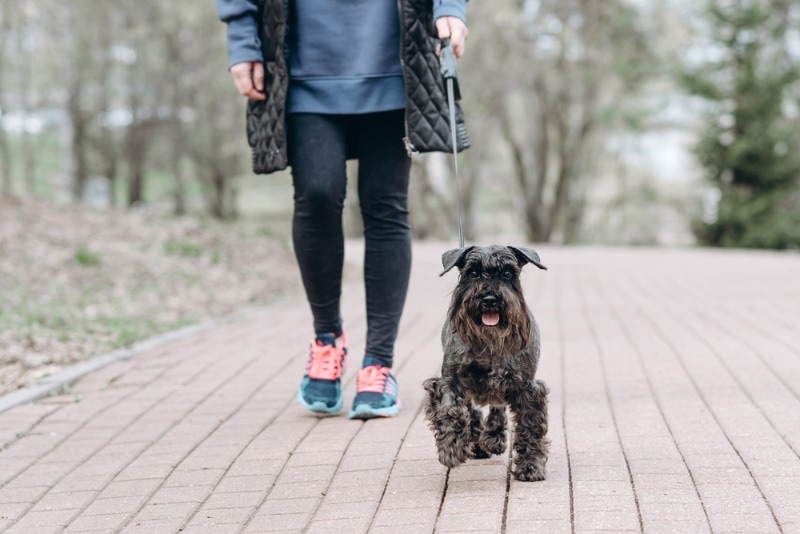Red Heeler Great Pyrenees Mix: Pictures, Care Guide, Temperament & Traits

Updated on
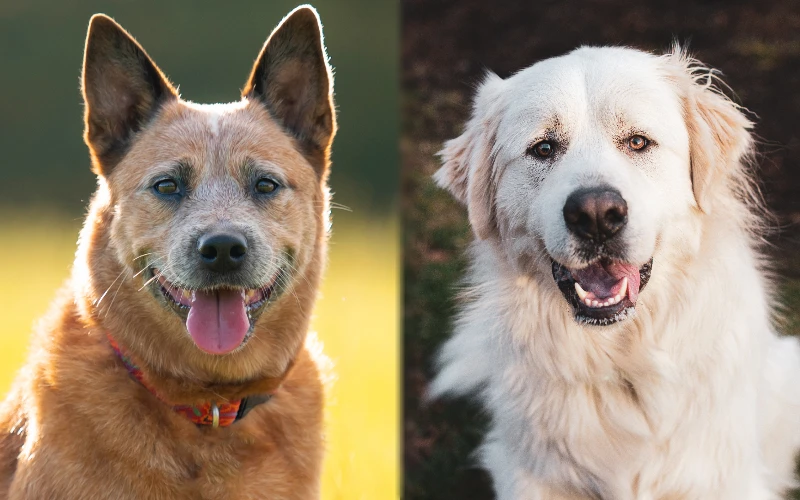
Click to Skip Ahead
When it comes to herding dogs and livestock guardians, the Red Heeler and the Great Pyrenees are two of the most popular breeds. The Red Heeler Great Pyrenees Mix, a cross of the two, has the traits that people love most in both parent breeds. They are a protective and loyal dog that’s eager to work and full of energy. This guide contains all you need to know about their care, along with a few interesting facts.
| Height: | 17–32 inches |
| Weight: | 33–125 pounds |
| Lifespan: | 10–16 years |
| Colors: | White, blue, red, speckled or mottled, with dark red, black, blue, tan, badger, or gray markings. |
| Suitable for: | Active families, rural or urban homes with a fenced yard, ranchers, experienced dog owners, families with older children |
| Temperament: | Loyal, protective, vigilant, easy-going, wary of strangers, active |
One of the newest hybrid dog breeds is the Red Heeler Great Pyrenees Mix. A cross between the Red Heeler, also known as the Australian Cattle Dog, and the Great Pyrenees, this dog is hardworking, intelligent, and protective.
The traits that they can inherit from their parents are difficult to determine since the breed is so new. They can be energetic like the Red Heeler or calm like the Great Pyrenees. Whatever their temperament is, though, all Red Heeler Great Pyrenees Mix dogs are fearless guardians and excellent companions for active families.
Red Heeler Great Pyrenees Mix Characteristics
Red Heeler Great Pyrenees Mix Puppies
The Red Heeler and the Great Pyrenees are both working dogs, but they have very different temperaments. This variation and how new the mix is makes it difficult to determine the temperament of any given puppy.
Some will take after the Red Heeler and have a keen herding instinct, a fondness for one member of the family, and boundless energy. Others might be happier to conserve their energy, be dedicated to everyone in the family, and be naturally protective, like the Great Pyrenees. Then, there are puppies that are an even mix of both breeds.
That said, there are a few similarities between the parent breeds, and the mix will likely also demonstrate these shared traits. Both dogs are loyal and protective of their family while being wary of strangers. Due to this, you must introduce your Red Heeler Great Pyrenees Mix puppy to as many people and situations as possible when they’re young.
It’s also important to remember that these hybrid puppies might be difficult to find to buy or adopt. If you can’t find a Red Heeler Great Pyrenees Mix anywhere nearby, try searching for alternative breed names. While the Great Pyrenees only has one name, the Red Heeler is also known as a Blue Heeler, a Queensland Heeler, or the Australian Cattle Dog.

Temperament & Intelligence of the Red Heeler Great Pyrenees Mix 🧠
Intelligence and a willingness to work are both traits that you can expect from a Red Heeler Great Pyrenees Mix. As a descendant of a herder and a livestock guardian, these dogs know the value of hard work and hate being idle. They might be more or less energetic and prone to nipping at ankles, depending on how much they take after their Red Heeler parent, but they’re always going to be loyal, dedicated, and protective guardians.
They’re not the most social hybrid breed out there, however. With two parents that are vigilant and prone to wariness around strangers, the Red Heeler Great Pyrenees Mix will need plenty of socializing. They build strong bonds with their family members, and without training, they can be aggressive toward people and animals that they deem to be threats.
Are These Dogs Good for Families? 👪
Generally, the Red Heeler Great Pyrenees Mix is an excellent dog for active families. However, keep in mind that some of the hybrids will be more affectionate than others. The Red Heeler tends to be a one-person dog, and their mixed puppies might be more standoffish in larger families except toward their favorite person. Dogs that take after the Great Pyrenees will be more affectionate to everyone in the family.
No matter which breed your Red Heeler Great Pyrenees Mix takes after the most, you need to supervise them around younger children. The Red Heeler Great Pyrenees Mix can be anywhere between 17 and 32 inches tall and weigh up to 125 pounds. While they’re gentle and loving, they can easily knock over a small child by accident. You also need to consider their energy level and whether they get over-excited easily.
Does This Breed Get Along With Other Pets?
Both the Red Heeler and the Great Pyrenees were bred to work closely with livestock animals. They herded cattle and protected sheep, respectively, and are still fiercely protective of what they consider theirs. As a result, both are comfortable around other pets, especially if they’ve grown up with other dogs around. They’ll likely get along with cats too, though some felines might be nervous around dogs that try to herd them too much.
When it comes to new dogs that you meet at the dog park, though, you need to make sure your Red Heeler Great Pyrenees Mix is socialized well as a puppy. Their wariness toward strangers extends to other dogs, and you need to take steps to make sure first introductions go smoothly inside and outside the house.
Things to Know When Owning a Red Heeler Great Pyrenees Mix
Although the Red Heeler and the Great Pyrenees were both bred for working with livestock, they had different jobs to do. Their varying energy levels, size, and coat all make caring for the two breeds different.
Therefore, it can be difficult to know exactly how to take care of the Red Heeler Great Pyrenees Mix. Here’s an overview of how the care needs of the Red Heeler and the Great Pyrenees could affect their puppies so you know what to expect.
Food & Diet Requirements 🦴
Whether you choose a high-energy food or one formulated for a more sedate lifestyle depends on which parent your Red Heeler Great Pyrenees Mix takes after most. You should always choose a high-quality food that meets AAFCO standards to make sure the ingredients are healthy and will supply your dog with the nutrition that they need.
Foods formulated for large breeds and their age are the best choices. You can even make your dog’s food at home if you follow the advice of a veterinary nutritionist. Fresh food subscription services are good options to try too.
The Red Heeler Great Pyrenees Mix might inherit the Great Pyrenees’s predisposition to bloat, so don’t feed them too much at once, and never exercise them immediately before or after eating.
Exercise 🐕
Despite being descended from two working dogs, the Red Heeler Great Pyrenees Mix can be either energetic or more sedate, depending on the breed that they take after. The Red Heeler was bred for endurance and is an active breed that isn’t suited to quiet families. In comparison, the Great Pyrenees prefers to conserve their energy until they need to protect their family.
The Red Heeler Great Pyrenees Mix can fall anywhere between the two extremes. You should adjust their exercise based on what works for your dog. Overall, you should expect to take at least two walks a day and spend time playing tug or fetch in a fenced yard or the dog park.
Training 🎾
Neither the Red Heeler nor the Great Pyrenees is suitable for new dog owners. The puppies can be just as energetic and in need of a job to do as the Red Heeler but also incredibly independent like the Great Pyrenees. This can make training them a challenge, especially if they take after the Great Pyrenees, which tends to respond to commands in their own time.
Despite the difficulty that you might have with training, basic obedience and socialization are essential. Puppy classes can work wonders, especially when you want to meet new dogs and people. The Red Heeler heritage also makes the Red Heeler Great Pyrenees Mix excellent for training in obedience, agility, and herding activities.
Grooming ✂️
If you want to avoid shed hair, the Red Heeler Great Pyrenees Mix isn’t the best choice. They can have short or medium-length fur that’s in a thick double layer to protect them from the elements. Unfortunately, their coat will shed excessively twice a year. If your hybrid puppy’s coat takes after their Great Pyrenees parent, you can expect them to shed throughout the year too.
Depending on their fur length, you’ll need a short bristle brush or a sturdy pin or slicker brush. Fortunately, the fur of both the Red Heeler and the Great Pyrenees is naturally resistant to tangles, odors, and dirt, so they won’t need many baths. Frequent brushing at least once a week or more should help control shedding.
Never forget their claws, teeth, and ears. Regular and thorough grooming sessions will keep your dog healthy and enable you to spot any health issues before they become big problems.
Health and Conditions ❤️
Mixed breeds like the Red Heeler Great Pyrenees Mix are generally healthier than pedigree breeds, but they can still be prone to common issues that affect their parents. Both the Red Heeler and the Great Pyrenees are prone to eye disorders and joint issues like hip dysplasia and patellar luxation.
The most serious condition that the Red Heeler Great Pyrenees Mix faces is bloat or GDV, due to the Great Pyrenees being predisposed to the condition. While the Red Heeler isn’t prone to bloat, you shouldn’t exercise your Red Heeler Great Pyrenees Mix immediately after they eat, just to be safe. Feeding them smaller meals throughout the day can also help lessen the risk.
The Red Heeler is prone to deafness, so make sure you regularly check your Red Heeler Great Pyrenees Mix’s ears for signs of infection or hearing loss.
- Progressive retinal atrophy
- Eye disorders
- Deafness
- Bloat
- Hip and elbow dysplasia
- Patellar luxation
Male vs. Female
Temperament-wise, one Red Heeler Great Pyrenees Mix might be vastly different from another. Many of the differences are inherited from the parent breeds, but their sex can also be influential. Like most dog breeds, the males are generally more affectionate than the females, while the latter are quicker to learn commands.
Do keep in mind that both parents play a part in your puppy’s temperament. The puppy might inherit the Red Heeler’s natural inclination toward one member of the family, which might lead to your male puppy seeming more aloof than a female mix that takes after the Great Pyrenees. Spend time getting to know your Red Heeler Great Pyrenees Mix before taking them home, to make sure they fit your family.
3 Little-Known Facts About the Red Heeler Great Pyrenees Mix
Young though the Red Heeler Great Pyrenees Mix might be, both their ancestral breeds have rich histories. This means there are plenty of interesting facts for you to learn, including an intriguing mixture of royal and wild dog ancestry.
1. They’re Descended From Wild Dogs
The Red Heeler Great Pyrenees might be far removed from the breeds that their parents originally descended from, but their ancestors still play a big part in what these dogs are like today. While the Great Pyrenees can be traced to domesticated dogs, the Red Heeler was descended from the Dingo, the Australian wild dog.
In the 1800s, when the British started settling in Australia, they found they needed a herding dog robust enough to handle the heat, terrain, and long distances. To reach their goal, they bred breeds like the Smithfield and the Scottish Collie with the native Australian dogs, including Dingoes.
Once this cross was developed properly by George Elliot, the dogs were crossed with Dalmatians and the Australian Kelpie by Jack and Harry Bagust. This cross led to the Red Heeler (or Australian Cattle Dog, as they’re also known) that we love today.
While the Dingo is a very distant ancestor now, their sturdy resilience still shines through in the Red Heeler Great Pyrenees Mix.
2. They’re Also Descended From Royalty
To make the Red Heeler Great Pyrenees Mix even more fascinating, the Great Pyrenees has a royal history. Although the breed was developed to work with peasant shepherds in the Pyrenees Mountains, their loyalty and protectiveness soon earned them attention from the French nobility.
During the reign of King Louis XIV in the 17th century, the Great Pyrenees proved themselves by guarding the chateaux. Their efforts earned them the title of “Royal Dog of France.”
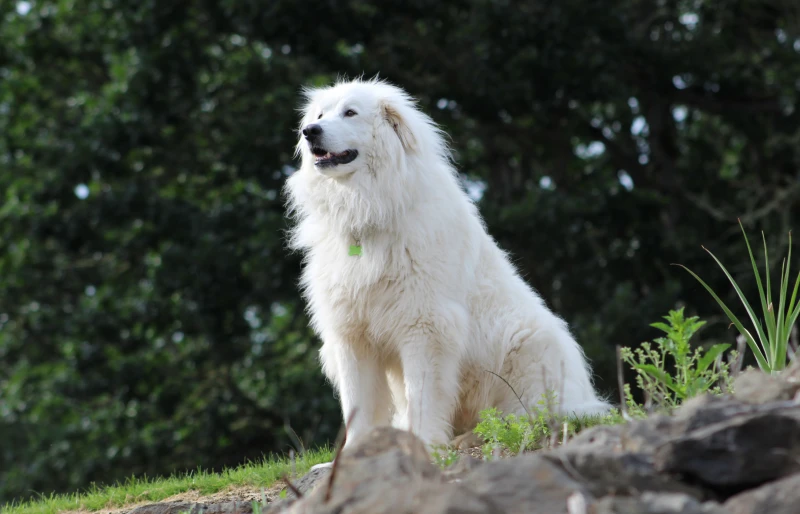
3. They’re Gentle But Fearless
Descended from two naturally vigilant and protective breeds, the Red Heeler Great Pyrenees Mix might be an excellent family dog, but they’re not afraid to dispose of threats. The Red Heeler is hardworking and loyal, with a fierce dedication to their owner and a willingness to work all day with enthusiasm and plenty of energy. Their wariness of strangers and their intelligence, along with their watchful nature, make them excellent guard dogs.
Similarly, the Great Pyrenees is a brilliant guardian, despite their easy-going and lazy temperament. While they’re renowned for their sedate, calm, and steadfast nature, they can quickly shift into a dog willing to fight wolves if necessary.
The Red Heeler Great Pyrenees Mix takes on both their parents’ temperaments. They’re gentle and affectionate, but socialization is essential for teaching them how to wield their fearless protectiveness.
Final Thoughts
If you’re looking for a livestock guardian and a good herding dog, a mix of two breeds is a great choice. The Red Heeler Great Pyrenees Mix combines the most loved traits of the Red Heeler and the Great Pyrenees into one bundle of fur.
That said, some of the puppies need more exercise than others, and they can be difficult to train due to their intelligence, size, and independent stubbornness. Whether they’re full of energy like the Red Heeler or happy to conserve their strength until they need it like the Great Pyrenees, these dogs are happy to work and often need a job to do.
They’re best suited to active families who are experienced with dogs, but they also get along well with children and other pets. The Red Heeler Great Pyrenees Mix is protective and will need socialization to teach them how to act around strangers. They might be calm and affectionate toward their family, but threats will be dealt with swiftly and efficiently, making them excellent guard dogs when properly trained.
Featured Image Credit: Left – Tanya Consaul Photography, Shutterstock | Right – Beatrice Foord-St-Laurent, Shutterstock



